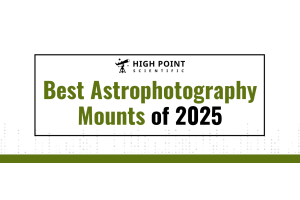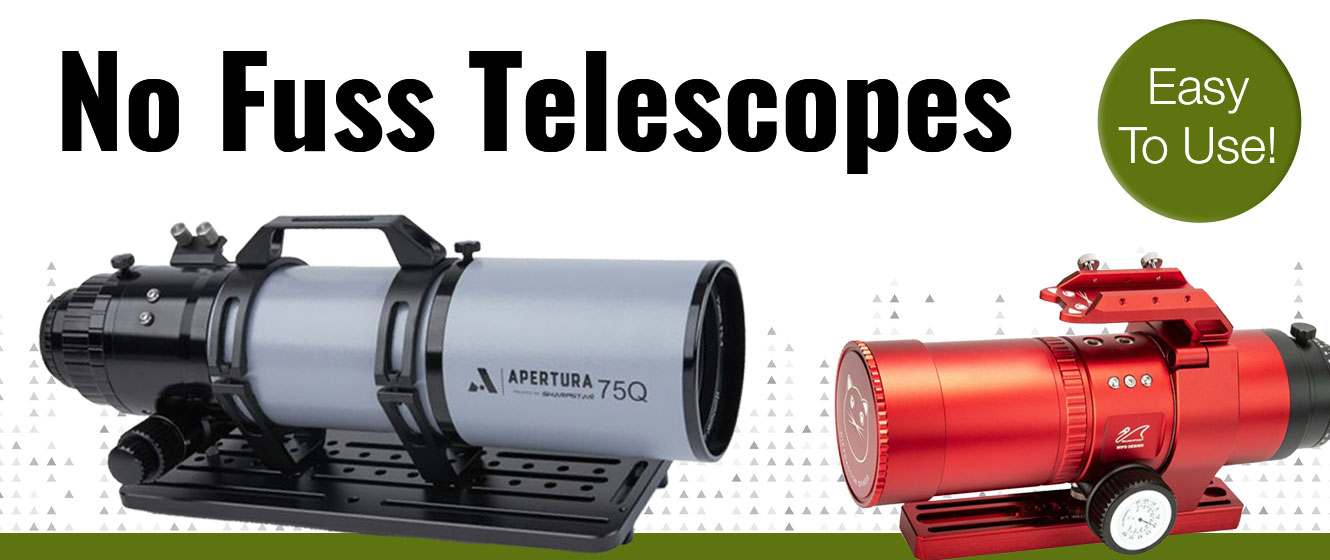
We have all been there. The exciting prospect of upgrading your astrophotography gear by purchasing a new telescope - yet there’s a looming cloud hanging over your head of the daunting worries that come with a new piece of equipment. Do I have the right spacers needed to find the correct backspacing? Am I going to have to learn how to collimate? What about coma correctors or field flatteners? Do I need to purchase one of those too? To put your mind at ease, here we have made a collection of no fuss telescope series - just attach your camera and you’re ready to go!
So, what is it exactly that makes a no fuss telescope no fuss? In this collection of easy to use telescopes, each model on the list contains these five qualities:
- No back spacing calculations required
- Apochromatic
- An inherent flat field
- No collimation necessary
- Full frame support
To truly understand the ingenuity of these telescopes, let’s break down these key characteristics that make them the most user-friendly systems on the market today.
The first aspect of a frustration-free system is the freedom from periodic alignment of its optical elements. With this in mind, refractors are arguably the easiest type of telescope to use. These lens-bearing telescopes don’t require the hassle of mirror collimation as seen in reflectors or catadioptrics, allowing you to capture beautifully sharp images straight out of the box. With refractors, the more lens elements there are, the better corrected the light will become, resulting in less aberration seen within the frames. Doublet refractors (2 lens elements) are often referred to as achromatic while triplet refractors (three lens elements) are frequently categorized as apochromatic.
What's the difference between achromatic and apochromatic? Achromatic lenses correct for light in two wavelengths, while apochromatic lenses correct for three wavelengths. With this additional lens, triplet refractors perform better than doublets, as they produce images free from coma, spherical, and chromatic aberration. Despite this, triplets still present another type of aberration - field curvature. While not a pressing issue for visual astronomers, the geometric mismatch of a curved optical plane and flat camera sensor results in distortions within the captured images. This aberration is seen as elongated stars around the edges of the frame and requires the addition of one more correcting lens element to straighten the incoming rays of light. Triplets can be coupled with a telescope-specific field flattener to achieve sharp stars all the way to the corners, though refractors containing a fourth correcting element, such as a quadruplet, act as a built-in field flattener! This inherent flat field also eliminates the need to calculate backspacing to reach the telescope’s required backfocus.
What is backfocus? Backfocus is the distance the imaging train must sit to reach a sharp, in-focus image across the entire field of view. With these no fuss telescopes, as long as you can reach focus, the entirety of the image will be in focus as well. To make these telescopes even more user-friendly, their image circles have a diameter of 43mm (the minimum diameter needed for use with full frame cameras) or greater. This support for full frame imaging allows you to add the vast majority of popular cameras available such as those from Canon, Nikon, Sony, ZWO, QHY, and plenty more!
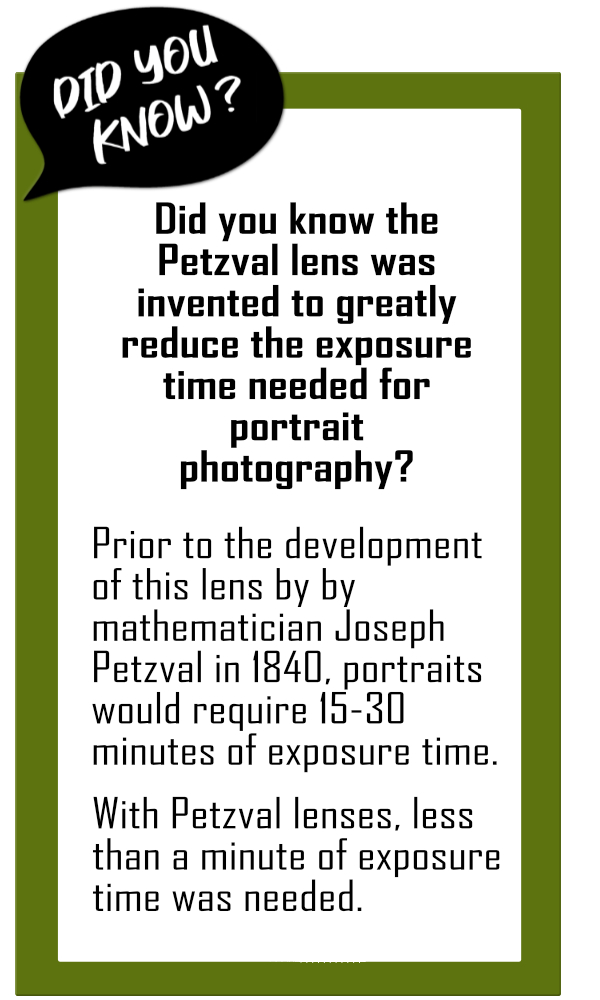

Thanks to the ingenuity from some of today’s most popular telescope manufacturers, having a telescope with all of these aspects is easily within your reach. They have done the homework for you, carefully crafting optics that deliver simplicity in use as well as superb performance. Whether you are a beginner looking for a user-friendly system, or an avid astrophotographer just wanting a simpler setup, here are our picks for the best no fuss telescopes for just about any experience level.
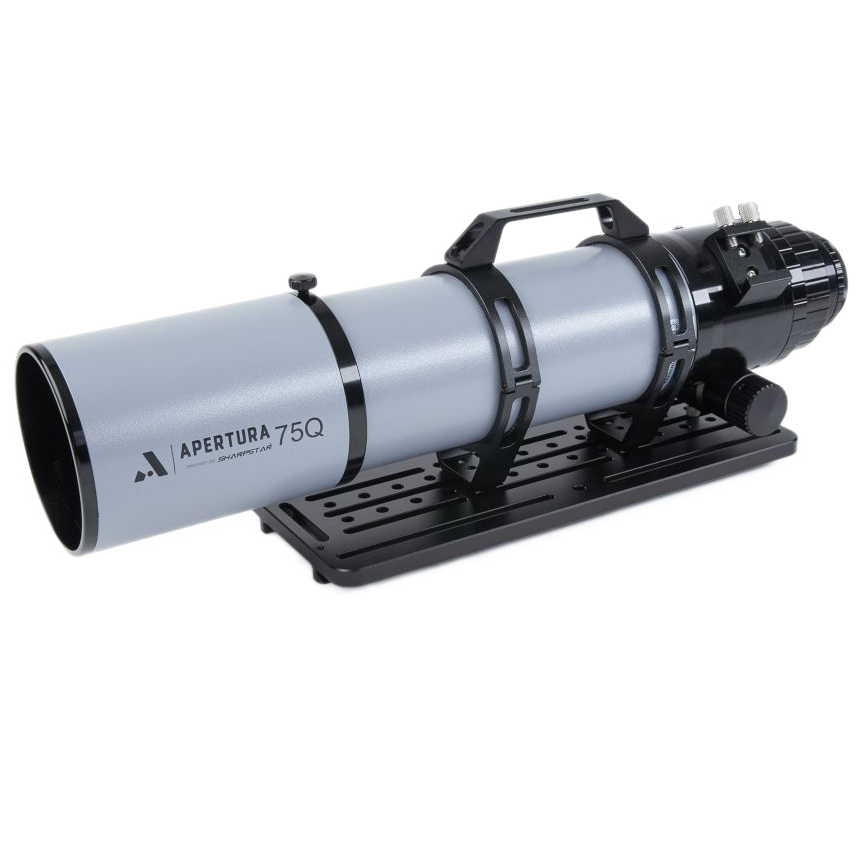
Apertura 75Q Refractor Telescope -
Created specifically for astrophotographers, this Apertura 75Q refractor provides exceptional color correction with its five optical elements and HOYA FCD-100 glass. The f/5.4 focal ratio and 405mm focal length is optimal for a wide range of targets including large, vast nebulae, intricate star clusters, and even distant galaxies! With its intrinsic flat field and full frame compatibility, seamlessly attach your favorite camera and rest assured knowing the stars will be sharp and pinpoint right to the edges of the frame. If using a one-shot-color (OSC) camera, the integrated 2” filter cell is incredibly convenient, as it allows you to thread in your favorite imaging filters for added versatility within your images. Weighing just 6.8lbs, this compact and portable refractor is perfect for any astronomy endeavor, and pairs nicely with today’s most popular travel mounts and star trackers. Developed by Apertura and powered by SharpStar, this high caliber refractor is sure to impress.
SHOP NOW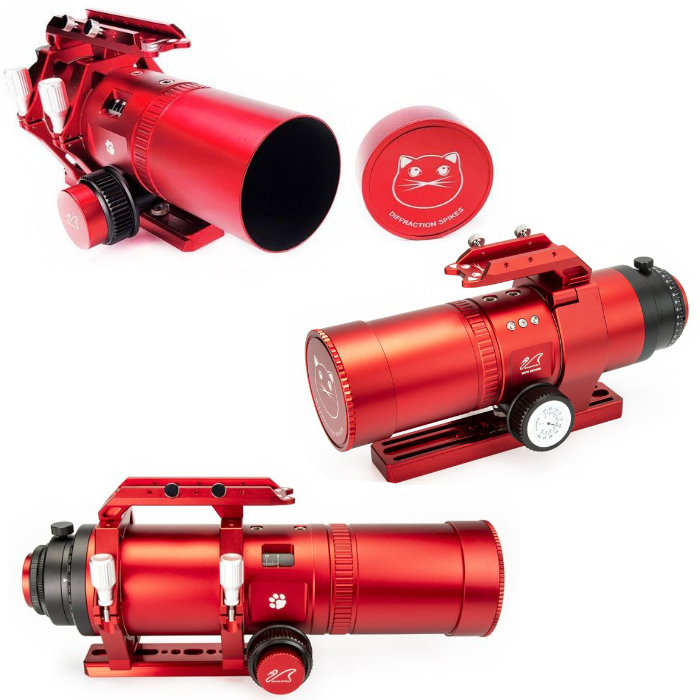
William Optics WIFD RedCat Refractors
RedCat 51 WIFD Refractor -
RedCat 61 WIFD Refractor -
RedCat 71 WIFD Refractor -
This William Optics telescope series is one of the most popular telescopes on the market today thanks to its user-friendly design. The signature all red body features four lens elements in a Petzval optical arrangement with FPL-53 glass for superb color correction. Three telescope sizes are available within the William Optics RedCat series: the RedCat 51 APO Refractor, RedCat 61 APO Refractor, and RedCat 71 APO Refractor. Each have a respectable f/4.9 focal ratio and supports full frame imaging! Also, the refractors within this series are furnished with the patented William Optics internal focusing design (WIFD). As opposed to moving the imaging train, the internal optics themselves shift to bring your telescope into sharp focus. This means your imaging equipment remains stationary, a trait that helps reduce the possibility of drawtube sag while also minimizing vignetting. In a small, lightweight package, take this capable, no fuss refractor with you on any astroimaging adventure!
SHOP NOW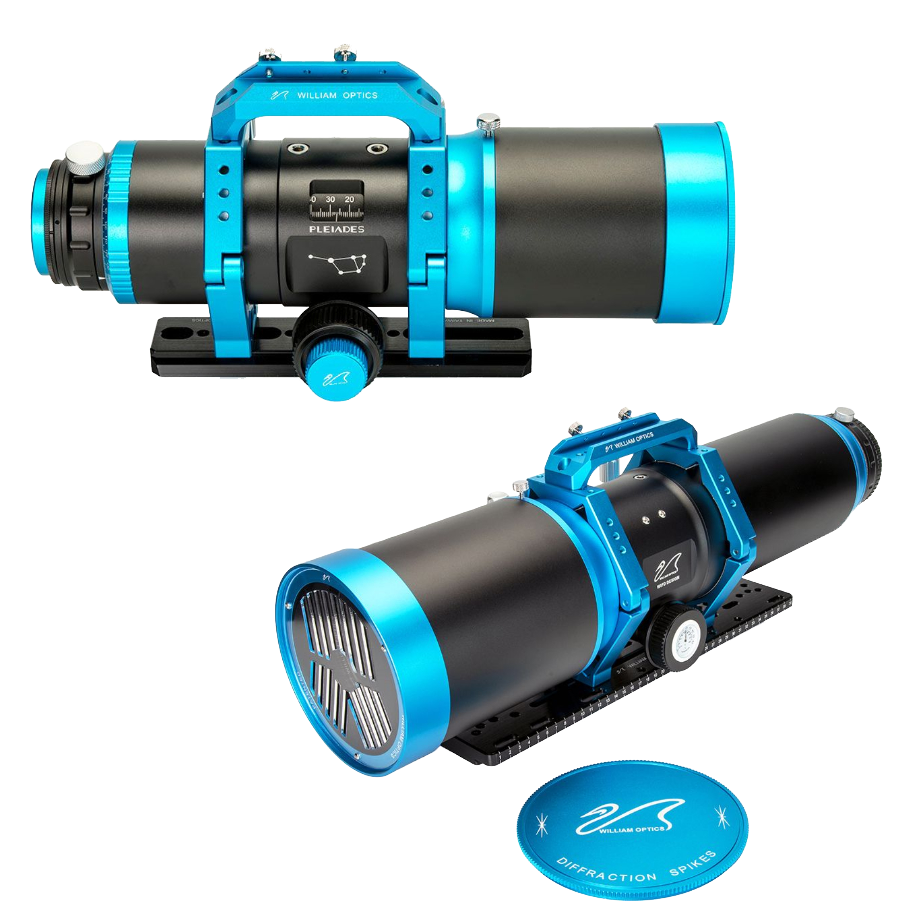
William Optics Pleiades Septuplet APO Refractors
Pleiades 68 WIFD Refractor -
Pleiades 111 WIFD Refractor -
One of the newest series from William Optics is their cutting edge septuplet Pleiades refractors. Assembled with an incredible seven optical elements and high quality FLP-53 glass, enjoy superior aberration correction for outstandingly sharp images. The Pleiades 68 features a focal length of 260mm and resulting focal ratio of f/3.8, a speed not typically found in other telescopes of similar focal lengths. In the same fashion, the wide aperture of the Pleiades 111 delivers a f/4.8 focal ratio, an impressive feat for its 530mm focal length. These two telescopes also come furnished with the William Optics internal focusing design (WIFD) for smooth, seamless focusing. Enjoy imaging in style with the sleek, black and blue finish and color coded accessories that come standard with these telescopes.
SHOP NOW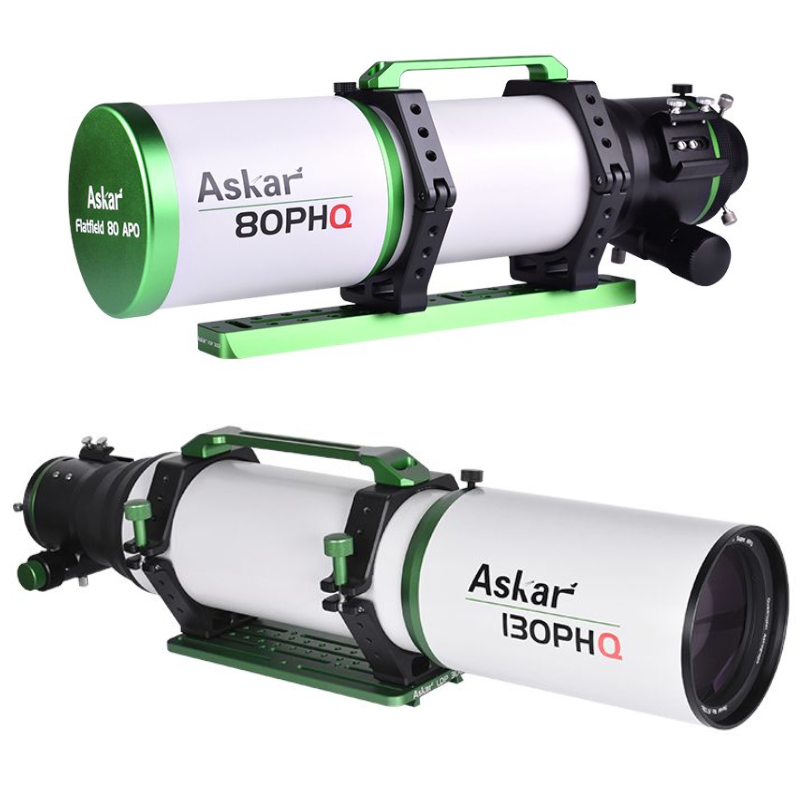
Askar PHQ Refracting Astrographs
65PHQ Refractor -
80PHQ Refractor -
107PHQ Refractor -
130PHQ Refractor -
151PHQ Refractor -
The PHQ series from Askar involves a collection of high performance refractors with impressive qualities. Each of these refractors are quadruplets, aside from the quintuplet-designed Askar 65PQH, and all offer exceptional color correcting abilities with their extra-low dispersion (ED) glass. Just about any camera can be added to these telescopes with its flat field full frame imaging capabilities, and the wide range of included adapters makes attachment a breeze. These models come standard with a convenient dual use carry handle, robust Rack & Pinion focuser, and matching Vixen-style dovetail plate to complement the green accented finish. Five different models reside in this series: the Askar 65PHQ, Askar 80PHQ, Askar 107PHQ, Askar 130PHQ, and Askar 151PHQ. With this wide variety of apertures and focal lengths ranging from 416mm to 1057mm, you’re sure to find a no fuss Askar PHQ telescope optimal for you!
SHOP NOW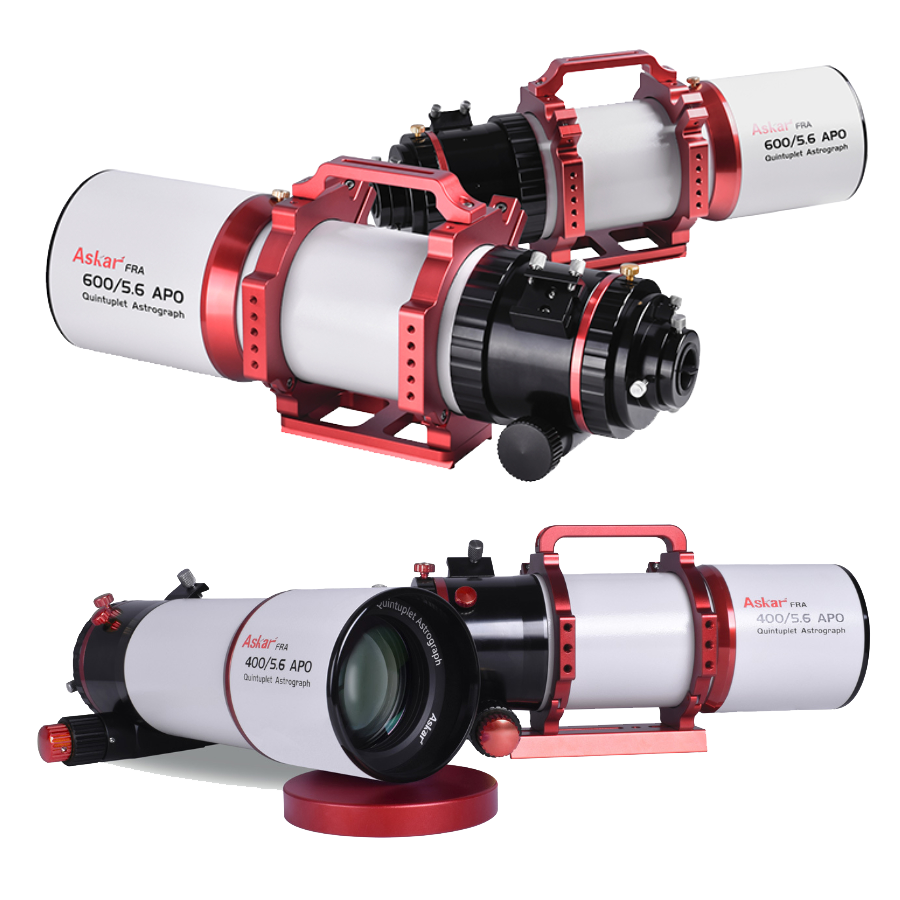
Askar FRA APO Refractors
FRA300 Pro Refractor -
FRA400 Refractor -
FRA500 Refractor -
FRA600 Refractor -
With FRA standing for “Flat-Field Refractive Astrograph,” the Askar FRA refractors within this series live up to their namesake by providing sharp stars across the entire frame. Five optical elements in a 3+2 Petzval-like configuration can be found in each of the four sizes available and provide heightened color correction and excellent contrast. Take your pick between the Askar FRA300 Pro, Askar FRA400, Askar FRA500, and Askar FRA600, with varying apertures ranging from 60mm to 108mm. These wide field astrographs feature several useful accessories to enhance your experience even more, such as a 360 degree camera rotator, retractable lens hood, precision-oriented Rack & Pinion focuser, and plenty more. No matter your needs, Askar has the perfect frustration-free telescope for you!
SHOP NOW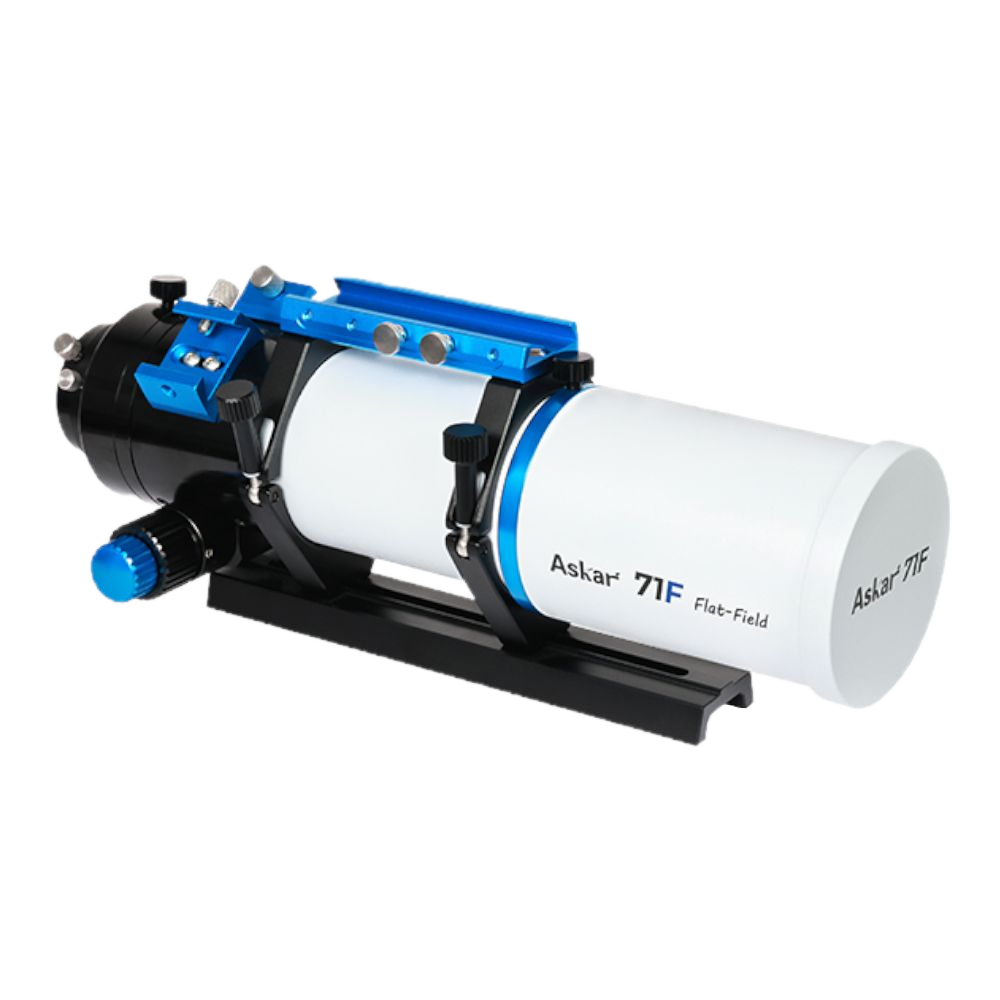
Askar 71F Flat-Field Refractor-
Wanting to start your astrophotography journey without breaking the bank? Askar introduces their 71F, an affordable air-spaced quadruplet refractor that provides excellent image quality! From the Andromeda Galaxy to the Orion Nebula - take advantage of the large 71mm of aperture and 490mm focal length for imaging a wide variety of celestial objects. Numerous inclusions make this a prime option for astrophotography, such as the onboard 360 degree camera rotator to help you find the perfect angle, or the dual-speed 2.4” rack and pinion focuser that’s EAF ready. Fitted with multiple adapters, attaching your camera is quick and effortless, and the four internal lenses provide an inherent flat field with no backspacing calculation required. Coming in at only 6.6lbs, take this small but mighty telescope with you on any astronomy adventure!
SHOP NOW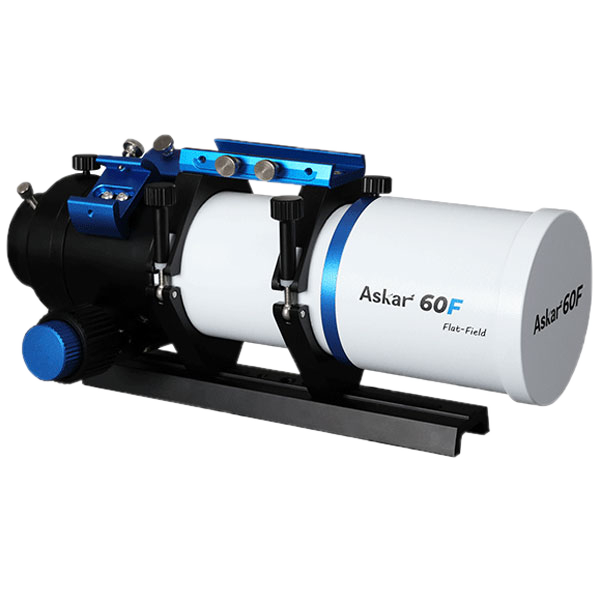
Askar 60F Flat-Field Refractor-
Another entry within the Askar Flat-Field Refractor series, the Askar 60F is a wonderful choice for those on a budget! This quadruplet telescope is highly versatile, hassle-free in nature, and packs a punch. Optimal for both astrophotography and visual astronomy, you’re set up for loads of fun under the stars. The four internal lenses are arranged within a 3+1 configuration, with one piece of extra-low dispersion (ED) glass within the front triplet lens group. The result is exceptional contrast and detail within your camera sensor and eyepieces. Boasting a 408 mm focal length and offering support for full frame cameras, a plethora of celestial objects are available for observation. Askar includes multiple accessories to help you get started: a photographic adapter set, two visual adapters, sturdy tube rings, several finderbases, and a handy Vixen-style dovetail base. A powerful pick for a wide range of applications, the Askar 60F Flat Field Refractor is a key addition to any astronomy toolkit!
SHOP NOW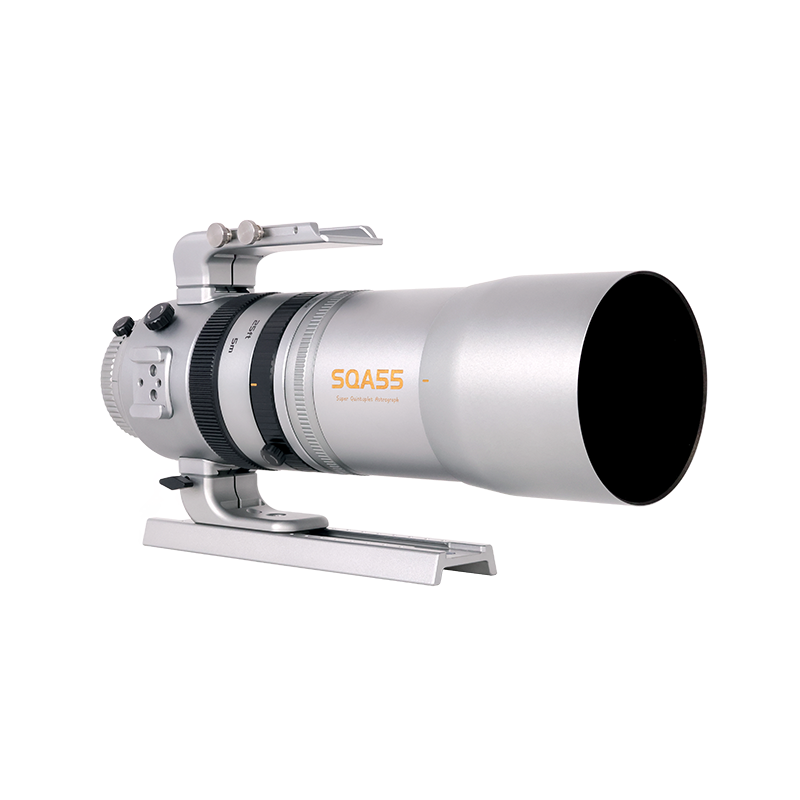
Askar SQA55 Quintuplet Refractor -
Askar has designed an innovative refractor that is not only optimized for astrophotography, but works perfectly as a lens for those who want to do daily photography. The Askar SQA Quintuplet Astrograph provides super fine star points and provides a robust number of features that will make your astrophotography session a breeze. With an aperture of 55mm, a focal ratio of f/4.8, and a quintuplet, air-spaced Petzval design, this small telescope can provide big performance value. Equipped with filter threads on both the front and back of the OTA, you can connect your 2" filters directly to the end of the refractor or connect M67 camera filters to the front of the lens. Versatile is an excellent way to describe the SQA55. It comes with a reversible lens hood design, a dual-speed focuser, and a dual rotator design. The dovetail and handle can be removed, allowing the refractor to be switched from OTA to camera mode quickly and easily. If that were not enough, Askar has included four multi-functional quick-release bases on the rear of the OTA for various accessory connections. These features mean that this refractor can be altered to fit your needs easily and without the need for additional tools.
SHOP NOW
Askar SQA85 Quintuplet Refractor -
The second entry into their SQA series, Askar introduces their SQA85! This powerful 85 mm refractor houses five internal air-spaced lens elements for superb color correction. Also, these elements provide an inherent flat field to ensure the stars and celestial objects stay sharp and pristine across the entire field of view. The best part of this Petzval design? No need to calculate back focus! As long as you can reach focus, the entire field of view will be in focus as well. The Askar SQA85 quintuplet includes a number of outstanding features that make it perfect for any astroimager. Including a 405 mm focal length, easily frame a wide variety of targets within the 44 mm image circle. The fast f/4.8 focal ratio collects copious amounts of light in little time, meaning you can complete your imaging projects in a quick, timely manner. Also, camera attachment is proven effortless thanks to the three included adapters (M68, M54, and M48). Demonstrating high end build quality within a sleek, stylish frame, this Askar SQA85 is crafted using CNC machining, and features the signature gray of the Askar SQA series. Numerous inclusions come standard with this high performance refractor, such as a Vixen-style dovetail, an accessory-ready tube ring, and an Oxford cloth carrying case for protection. With this Askar SQA85, you’re set up for success!
SHOP NOW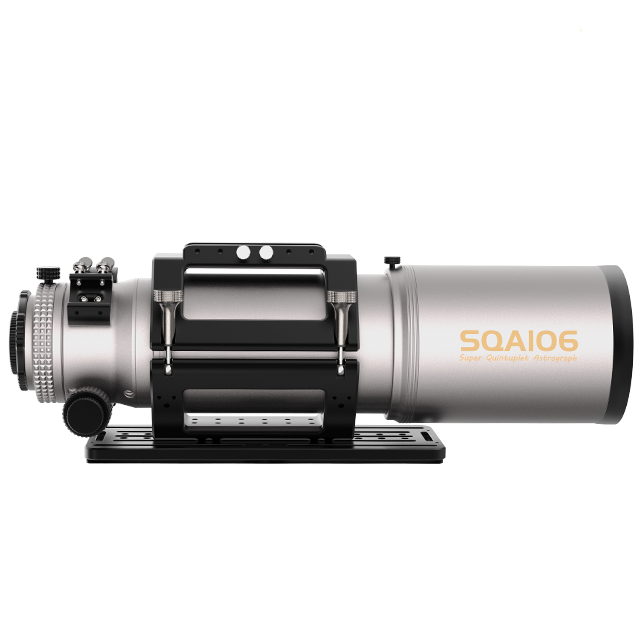
Askar SQA106 Quintuplet Refractor -
Continuing with the SQA series from Askar, the SQA106 is the largest yet in the collection! The 106 mm (4.17”) aperture acts as a light bucket, collecting an abundance of light for beautifully bright images. With five internal air-spaced lens elements, the incoming light is well corrected, providing superb color accuracy, high contrast, and sharp detail. Thanks to the Petzval design, not only can you skip pesky backfocus calculation, but you can also take advantage of the inherent flat field for sharp stars across a 55 mm image circle. This wide image circle paired with the 509 mm focal length is wonderful for filling the frame with sweeping nebulosity, and the focal ratio of f/4.8 means you can complete imaging projects within a speedy timeframe. In addition to this premier optical design, Askar has added numerous accessories within this package to help you get the most out of your imaging sessions! Multiple rear-end adapters make it easy to find the right connections for your imaging train, while two finderbases make accessory attachment a breeze. Also included is a tube ring with a multifunctional finderbase, a 300 mm Losmandy-style dovetail, and a high quality Oxford cloth case. This refractor is crafted with high quality CNC machining, and includes the signature grey of the SQA series. By combining powerful optics, functionality, and a sleek, stylish design, this Askar SQA106 is the choice for those looking to take their astrophotography to the next level!
SHOP NOW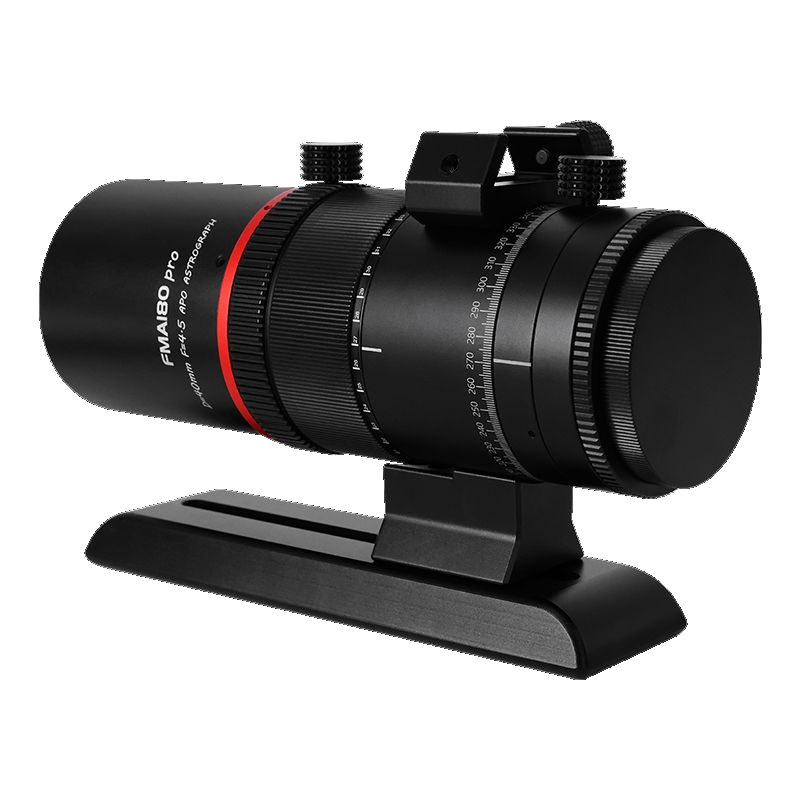
Askar FMA180 Pro Sextuplet APO Refractor -
Another astrophotography lens from Askar, this FMA180 Pro has the familiar feel of a lens with the excellence of a telescope, making it a great stepping stone for those making the transition into astrophotography. Six optical elements in a 3+3 arrangement offer exceptional correction for sharp, clear images, and comes with a built-in 2” filter thread for various imaging applications. The broad 180mm focal length paired with the 44mm image circle makes this a wide-field powerhouse, allowing you to capture vast nebulous regions of our Milky Way Galaxy. Weighing less than 2lbs, this tiny sextuplet lens can be taken with you anywhere. Bring it on camping trips and take advantage of both its astrophotography and daytime landscape performance!
SHOP NOW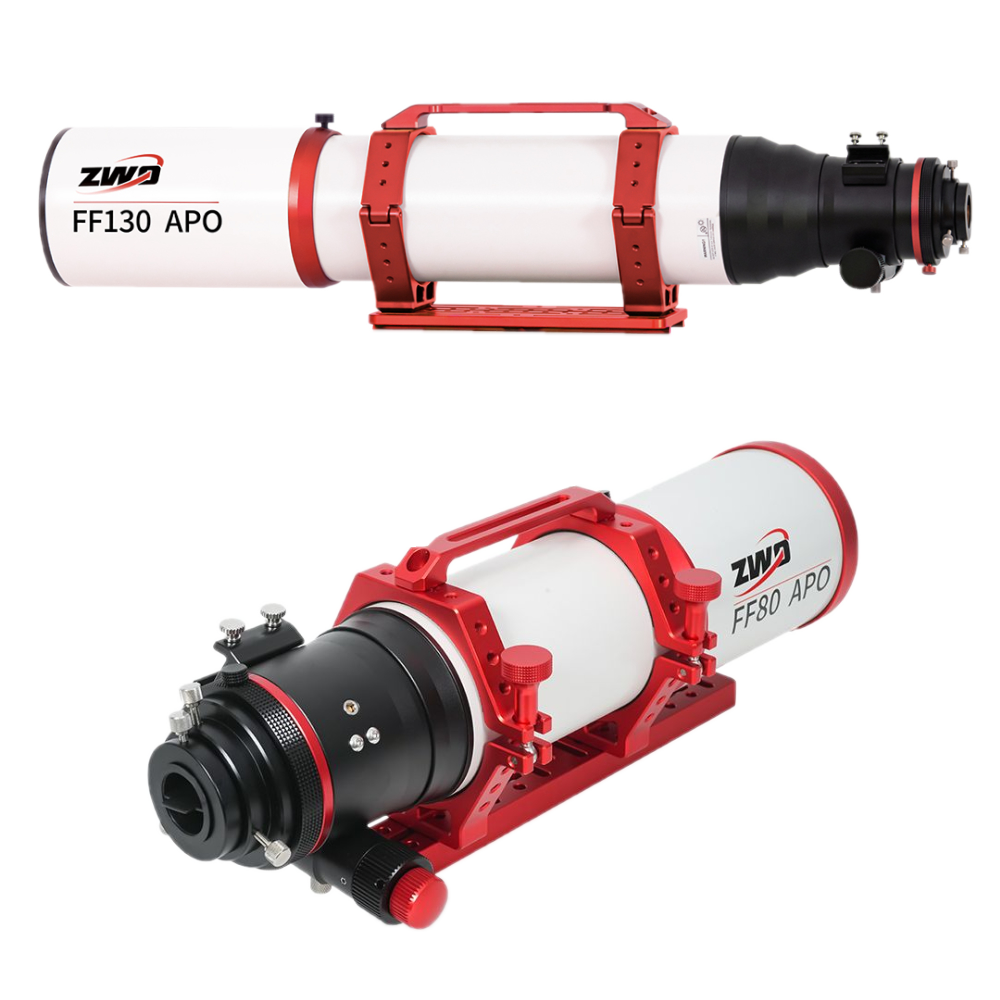
ZWO Apochromatic Refractors
65mm APO Refractor -
80mm APO Refractor -
107mm APO Refractor -
130mm APO Refractor -
Known for their industry leading cameras, ZWO has taken their superb astrophotography innovations a step further by introducing their line of high performance refractors! This collection of telescopes feature the ZWO 65 mm Quintuplet, ZWO 80 mm Quadruplet, ZWO 107 mm Quadruplet, and ZWO 130 mm Quadruplet. The focal lengths of this series range from 416mm to 1000mm, allowing you to choose the best telescope for the field of view of your preference. Also, an image circle of at least 44mm can be found on these telescopes (the ZWO 130 mm Quadruplet supports a large 60mm image circle), and come equipped with multiple adapters for seamless addition of a variety of different cameras. ED glass comes standard on all models for heightened color correcting abilities, making these a prime choice for astrophotography!
SHOP NOW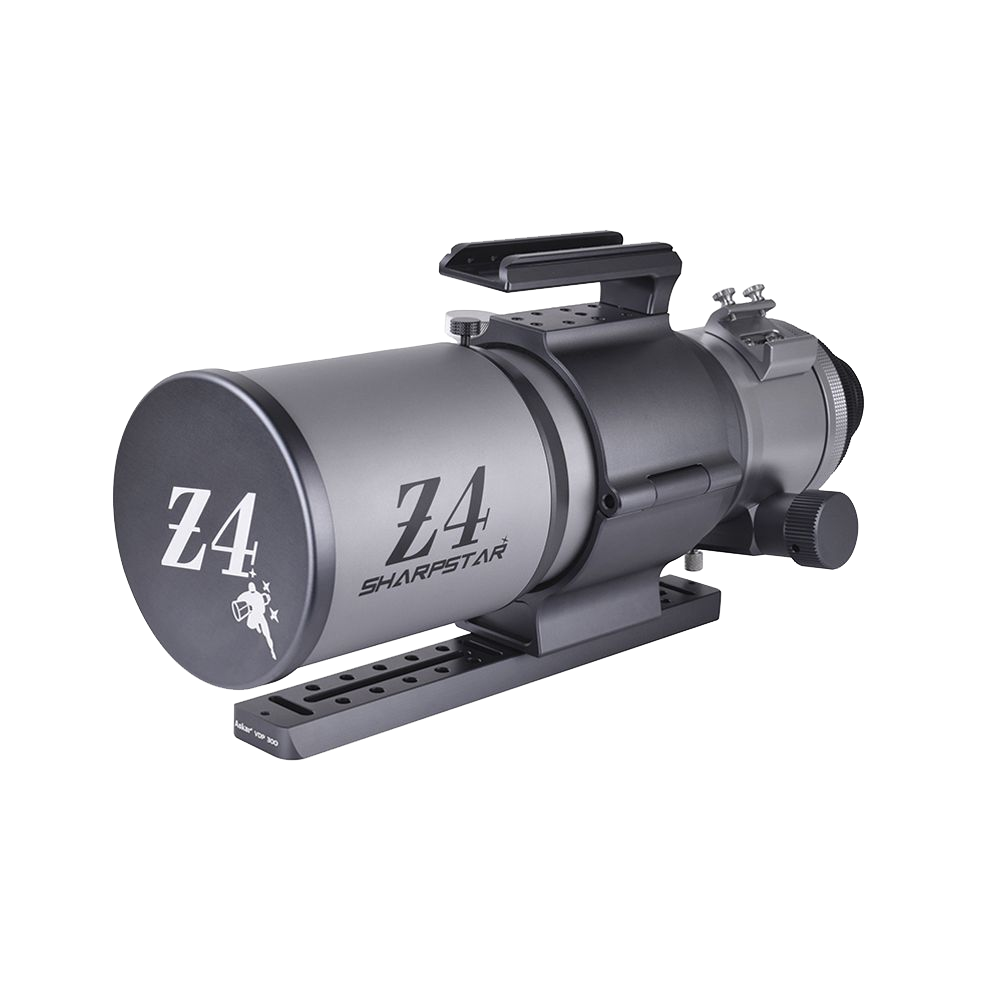
HONORABLE MENTION - Sharpstar Z4 Sextuplet Dual-ED APO Refractor -
This apochromatic Sharpstar Z4 provides superb color correction within the images taken thanks to its 6 internal optical elements and ED glass. There is no need to calculate backspacing with its inherent flat field, and the medium-range 550mm focal length is suitable for a wide array of targets such as large nebulae and galaxies. The stylish matte gray OTA comes fitted with matching accessories such as a robust tube ring, dual use carry handle, 10:1 Rack & Pinion focuser, and Vixen-style dovetail, providing an attractive two-toned system. This package also comes standard with multiple adapters for effortless addition of your camera. While featuring a 36mm image circle and only supporting APS-C sized sensors, the Sharpstar Z4 is our pick for honorable mention in this collection of no fuss telescopes.
SHOP NOWGlossary
Backfocus / Backfocal Distance / Backspacing
All optical systems have a point at which an in-focus image is formed, and for astrophotography it is at this location that the camera sensor should be placed. When the telescope is used without corrective elements, this is done easily with the focuser mechanism; and so long as an image can be brought into focus, optimal optical performance will be achieved. However with corrective elements, oftentimes there is a certain distance that the camera sensor needs to be placed away from the rear of the corrector for optimal performance. This will be listed as the backspacing or backfocal distance for the corrective element.
Chromatic Aberration
Different wavelengths of light travel at different speeds based on the medium it occupies. When white light is exposed to glass such in a telescope or lens, blue light, red light, and green light slow at varying rates. This change of speed causes each wavelength to focus at different points along the focal plane, resulting in color fringing seen within the images taken.
Collimation
Collimation is the process in which the optical elements of a telescope are aligned to deliver the best performance possible. In refracting optical systems, lens collimation is performed by the manufacturer at the time of assembly. In contrast, reflecting telescopes contain mirrors that are often bumped out of alignment. As a result, these types of telescopes require periodic collimation from the user to ensure peak clarity and sharpness. Various tools are available for collimation, such as laser collimation, Cheshire eyepieces, and collimation caps, just to name a few.
Coma
Coma is the comet-like appearance of stars near the edges of the frame. This occurs when light entering the optics focuses at different points around the corners of the image, causing an overlap of unfocused stars that present itself in a trailing manner.
Doublet Refractor
A doublet refractor is a type of telescope that utilizes two lens elements. Often referred to as achromatic doublets, the use of two lenses help reduce the detrimental effects of common aberrations by focusing red and blue light on the same focal plane. These types of refractors are popular with beginners as they perform well, are easy to use, do not require collimation, and are generally quite affordable.
Extra-Low Dispersion (ED) Glass
ED stands for “extra-low dispersion”, and is a type of glass designed to specifically reduce the separation of wavelengths when light passes through. Coatings of magnesium fluoride, zirconium dioxide, calcium fluoride, and titanium dioxide help bridge the gap between the different wavelengths of light, providing a singular focal point for all wavelengths. This helps reduce chromatic aberration and in turn provides heightened optical performance. Also, the more coatings on the lenses, the higher the transmission rate becomes for brighter, more detailed views and images.
Image Circle
This specification refers to the area where an image is formed by the optics/ corrective element. This is useful for assessing whether a certain camera sensor size will be supported by the optics, or if vignetting/ poor performance will be seen in frame.
Petzval Design
The Petzval design is an orientation of lens elements within a refractor telescope. This arrangement features a doublet near the front of the optical tube, and a doublet near the back of the tube, with air-spacing in between. The second doublet corrects for aberrations that the first was unable to correct for, such as comatic aberration and field curvature. As a result, refractors of this design are well suited for astrophotography, producing exceptional clarity and contrast within the images captured.
Quadruplet Refractor
Quadruplet refractors contain a total of four internal optical elements that provide images free from chromatic, comatic, and spherical aberration. As opposed to triplet refractors, quadruplet refractors also correct for field curvature aberration, where the additional lens acts as a built-in field flattener to straighten out incoming rays of light. This flat field also means there is no need to calculate backspacing; as long as the imaging system can reach focus, stars will be sharp across the entirety of the image. The four lenses in these telescopes can be arranged in various different orientations, though most often adopts the Petzval design. This design features two lenses in the front and two in the rear, and is so often used that quadruplets are regularly referred to as Petzval refractors. Most of the quadruplets produced today are manufactured specifically for astrophotography, and do not allow visual applications.
Quintuplet Refractor
Quintuplet refractors are telescopes that include a total of five lens elements. These lenses can be combined in various different arrangements to deliver superb color correcting abilities. Common aberrations such as chromatic, comatic, spherical, and field curvature are eliminated when using telescopes of this design, making them optimal for astrophotography. The inherent flat field also eradicates the need to calculate backspacing, making them exceptionally easy to use.
Rack & Pinion Focuser
Rack & Pinion focusers utilize a gear-oriented system to bring the telescope into focus. When the focusing knob is turned, the gears of the Pinion mechanism mesh with those of the Rack mechanism to move the eyepiece or imaging equipment into the focal point of the optics. By using gears, this type of focusing design is less likely to suffer from slippage as other focusers are prone to, and are one of the most commonly used in today’s most popular telescopes.
Refractor / Refracting Telescope
A refractor is a telescope design that uses lenses to gather and focus light. While there are some exceptions to the rule, achromatic refractors use two lenses in their design, and while they are economical, achromats are only capable of focusing two out of three wavelengths of light. An APO telescope, or apochromatic refractor, uses 3 lenses to bring all three wavelengths of light to a single focus to produce an image virtually free of extraneous color.
Septuplet Refractor
Septuplet refractors house seven lens elements for outstanding astrophotography performance. Aberration is virtually non-existent with this multitude of correcting lenses, providing images with heightened clarity and contrast. There is no backspacing calculation required from the user as long as the imaging equipment can reach focus, and the inherent flat field provides sharp stars from corner to corner.
Sextuplet Refractor
Sextuplet refractors are telescopes that contain six lens elements. These six correcting lenses provide excellent aberration correction, producing images free from coma, chromatic aberration, spherical aberration, and field curvature. Telescopes of this design have a built-in field flattener, and don’t require backspacing calculations as long as the imaging assembly can reach focus. These qualities make sextuplet refractors the ideal choice for astrophotographers wanting high quality, well-corrected images.
Spherical Aberration
As opposed to converging at a singular focal point, light rays entering the edges of a lens focus at differing points than that of light rays entering the center of the lens. This results in sharp stars in the center of the frame while blurry, unfocused stars are prevalent around the edges of the image.
Triplet Refractor
Triplet refractors house three lens elements that work together to eliminate common aberrations such as chromatic, comatic, and spherical. While achromatic doublets only correct for two wavelengths (red and blue), apochromatic triplets correct for three, allowing red, green, and blue light to become focused along the same focal plane. These types of refractors excel for visual use though are especially popular within the astrophotography community thanks to their superb color-correcting abilities.
Vignetting
Vignetting is seen as the darkening of the corners of the frame within an image. This happens when the camera sensor is not exposed to enough light, resulting in a shadow effect along the borders of the image. This issue presents itself for a number of reasons, though most commonly occurs when using incompatible sensor sizes and image circles, and the use of too small of filters for the imaging assembly.

Learn More
Interested in learning more about telescopes, astronomy, or astrophotography? Not sure where to begin? Check out our AstronomyHub!
This Article was Originally Posted on March 27th, 2024


































